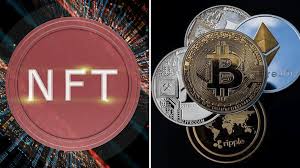Understanding the Differences Between Blockchain for NFTs and Cryptocurrencies
The blockchain revolution has unlocked an entirely new digital economy — one that includes both cryptocurrencies and non-fungible tokens (NFTs). While they share a common technological foundation, their purposes, design, and value models are different.
In this deep-dive, we’ll explore how blockchain powers each and why understanding the differences is essential for investors, developers, and digital creators.
1. The Foundation: Blockchain Technology
Before comparing NFTs and cryptocurrencies, it’s important to understand what they have in common: blockchain.
A blockchain is a decentralized, immutable digital ledger where transactions are recorded and verified by multiple participants (nodes) without the need for a central authority. Both NFTs and cryptocurrencies use this ledger to store data, ensure authenticity, and enable peer-to-peer transfers.
However, what they store and how they use it are fundamentally different.
2. Core Purpose and Use Cases
The biggest distinction lies in why each type of blockchain token exists.
| Feature | Blockchain for NFTs | Blockchain for Cryptocurrencies |
|---|---|---|
| Goal | To represent, prove ownership of, and trade unique digital or physical assets | To serve as a medium of exchange, store of value, or utility token |
| Example Assets | Digital art, collectibles, in-game items, event tickets, real estate deeds | Bitcoin, Ethereum, stablecoins, governance tokens |
| End Users | Artists, gamers, collectors, brands | Traders, investors, everyday spenders, decentralized finance users |
In other words:
- NFT blockchains are like digital galleries or asset registries.
- Cryptocurrency blockchains are like digital banks.
3. Fungibility: The Fundamental Difference
The terms fungible and non-fungible explain why NFTs and cryptocurrencies behave differently.
| Term | Meaning | Application |
|---|---|---|
| Fungible | Every unit is identical and interchangeable | 1 Bitcoin = any other Bitcoin |
| Non-Fungible | Each unit is unique with distinct properties | “Bored Ape #1234” ≠ “Bored Ape #5678” |
Cryptocurrencies like Bitcoin or Ethereum are fungible — much like cash, where $10 in one person’s wallet is the same as $10 in another’s. NFTs, on the other hand, are non-fungible — more like a painting or a rare collectible card, each with its own identity.
4. Token Standards and Architecture
NFTs and cryptocurrencies use different token standards that define how they operate on a blockchain.
| Blockchain Type | Common Token Standard | Key Characteristics |
|---|---|---|
| NFTs | ERC-721 (single unique assets) and ERC-1155 (multiple asset types in one contract) | Includes metadata (e.g., creator name, artwork image URL, traits) |
| Cryptocurrencies | ERC-20 (Ethereum) or native blockchain protocols (Bitcoin’s UTXO model) | Tracks balances, supports token transfers, and ensures divisibility |
💡 Note: Ethereum is a common platform for both, but the token contract type changes depending on the asset’s intended use.
5. Metadata vs. Ledger Balances
Both NFTs and cryptocurrencies live on blockchain ledgers, but the kind of data they store is very different.
| Aspect | NFTs | Cryptocurrencies |
|---|---|---|
| Data Stored | Ownership details, metadata, links to digital assets, traits, rarity info | Wallet addresses and balances |
| Data Purpose | To prove authenticity and uniqueness | To enable secure peer-to-peer transactions |
| Size of Data | Often larger due to metadata | Generally smaller, numeric balance updates |
For example, an NFT’s metadata may include an image file hash, a description, and special attributes, while Bitcoin’s ledger only records the amount transferred and addresses involved.
6. Value Drivers: Why People Buy Them
The factors influencing the value of NFTs and cryptocurrencies diverge sharply.
| Value Driver | NFTs | Cryptocurrencies |
|---|---|---|
| Scarcity | Limited edition drops, unique asset properties | Fixed or predictable token supply (e.g., Bitcoin’s 21M cap) |
| Utility | Access to communities, in-game benefits, event tickets | Payments, staking, governance rights |
| Cultural/Brand Power | Artist reputation, project hype, celebrity endorsements | Network adoption, institutional backing, developer activity |
| Market Trends | Popularity of Web3 gaming, metaverse, and collectibles | Global economic trends, regulatory changes, DeFi growth |
7. Examples in Action
To better understand, let’s look at real-world examples.
| Category | NFT Example | Cryptocurrency Example |
|---|---|---|
| Art & Collectibles | CryptoPunks, Bored Ape Yacht Club | — |
| Gaming | Axie Infinity characters, Illuvium land plots | In-game currencies like AXS or ILV tokens |
| Music | Royal.io music rights NFTs | — |
| Payments | — | Bitcoin (BTC), Litecoin (LTC) |
| DeFi | NFT collateralized loans | Ethereum (ETH) for lending/borrowing |
8. Interoperability and Platforms
Some blockchains are optimized for both NFTs and cryptocurrencies, while others are built for one primary function.
| Blockchain | NFT Support | Crypto Support | Notable Strength |
|---|---|---|---|
| Ethereum | Yes | Yes | Largest NFT ecosystem, strong DeFi presence |
| Polygon | Yes | Yes | Low fees, NFT integrations for gaming |
| Flow | Yes | Limited | NFT-first blockchain (NBA Top Shot) |
| Bitcoin | Limited (via Ordinals) | Yes | Secure store of value |
| Solana | Yes | Yes | Fast transactions, NFT-friendly tooling |
9. Misconceptions and Overlaps
A common misunderstanding is thinking NFTs and cryptocurrencies are different technologies. In truth:
Both are blockchain tokens — the difference lies in their data structure and intended purpose.
Sometimes, a project may combine both worlds. For example:
- An NFT game might use a cryptocurrency token for in-game purchases, while also issuing NFTs for characters and assets.
- A DeFi protocol could use NFTs to represent special membership tiers, while still running a standard ERC-20 governance token.
10. Risks and Challenges
Both NFTs and cryptocurrencies carry their own risks.
| Risk Type | NFTs | Cryptocurrencies |
|---|---|---|
| Market Volatility | Prices can crash if project loses popularity | Prices can crash due to market cycles |
| Liquidity | Low for niche NFTs — hard to sell quickly | Higher liquidity but still market-dependent |
| Regulation | Unclear IP rights, licensing issues | Increasing scrutiny from governments |
| Security | Smart contract vulnerabilities, metadata storage risks | Exchange hacks, phishing attacks |
11. The Future: Convergence or Divergence?
The lines between NFTs and cryptocurrencies may blur further:
- NFTs as financial instruments: Collateralized loans, tokenized real estate, fractional ownership.
- Cryptocurrencies with NFT-like features: Unique staking badges, proof-of-participation rewards.
- Cross-chain ecosystems: Assets freely moving between NFT-centric and crypto-centric blockchains.
12. Quick Analogy Recap
| Item Type | NFT Equivalent | Cryptocurrency Equivalent |
|---|---|---|
| Museum | Every artwork has a catalog entry (unique) | — |
| Bank | — | All $100 bills are the same |
| Sports Card Collection | Each card has its own stats and rarity | — |
| Digital Wallet Balance | — | All tokens of same type are identical |
💡 Think of NFTs as deeds to unique things, and cryptocurrencies as the currency used to buy them.
Final Thoughts
NFTs and cryptocurrencies are two sides of the same blockchain coin — one focused on uniqueness and ownership, the other on exchange and fungibility. Understanding their distinctions can help you:
- Invest smarter
- Choose the right blockchain platform
- Build products that leverage the right token type
As blockchain adoption accelerates, we’ll likely see more hybrid applications combining both NFTs and cryptocurrencies into unified ecosystems. Whether you’re a creator, investor, or just curious about Web3, knowing the difference between the two is a fundamental step toward navigating the future of the digital economy.
If you want, I can now design a visual flowchart that shows how NFT and cryptocurrency transactions differ on-chain so this blog post has a strong visual hook for readers. That would make it even more engaging.



























